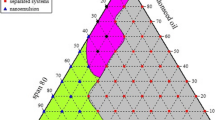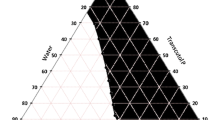Abstract
The aim of the present investigation was to develop and evaluate Butenafine Hydrochloride loaded microemulsion based gel for treatment of fungal infection. Pseudo ternary phase diagrams were constructed for different microemulsion formulations composed of Capmul MCM as oil, Cremophor RH 40 as surfactant and Transcutol HP as co-surfactant. Composition of microemulsion system was optimized using simplex lattice mixture design including the concentration of oil, Surfactant co-surfactant ratio (Smix) and water (independent variables) and the % transmittance and globule size of microemulsion (response variables). The physicochemical properties of the optimized microemulsion were investigated. Microemulsion was incorporated into 1 % carbopol 934P gel and the ex vivo drug permeation of gel was also investigated. The results showed that the optimized microemulsion formulation was composed of Capmul MCM oil (5 %, w/w), Cremophor RH 40/Transcutol HP (43.333 %, w/w) and water (51.667 %, w/w). The mean globule diameter was 108.8 nm. The conclusion was that the release controlling ability of microemulsion containing gel formulation was significantly improved in comparison to commercial cream. Skin irritation study was also performed and it shows no irritation on rat skin after 24 h of application. Microbiological assay of Butenafine Hydrochloride was performed where it shows better zone of inhibition than marketed formulation.












Similar content being viewed by others
References
Barot BS, Parejiya PB, Patel HK et al (2012) Microemulsion-based gel of terbinafine for the treatment of onychomycosis: optimization of formulation using D-optimal design. AAPS Pharm SciTech 13:184–192. doi:10.1208/s12249-011-9742-7
Bharadwaj S, Gupta G, Sharma V (2012) Topical gel: a novel approach for drug delivery. J Chem Biol Phys Sci 2:856–867
Dabhi MR, Nagori SA, Sheth NR et al (2011) Formulation optimization of topical gel formulation containing microemulsion of terbinafine hydrochloride with simplex lattice design. Micro Nanosyst 3:1–7. doi:10.2174/1876402911103010001
Dadwal M (2013) Emulgel: A novel approach to topical drug delivery. Int J Pharma Biol Sci 4:847–856
Doaa AH, Dalia ELR, Sally AH, Mohamed AN (2012) Formulation and evaluation of fluconazole stopical gel. Int J Pharm Pharma. Sci 4:178
Goldin H (1996) Association of athlete’s foot with cellulitis of the lower epidermis: diagnostic value of bacterial cultures of ipsilateral interdigital space samples. Clin Infect Dis 23:1162–1164
Gupta AK (2002) Butenafine: an Update of Its Use in Superficial Mycoses. Skin Ther Lett 7:1–5
Jadhav KR, Shetye SL, Kadam VJ (2010) Design and evaluation of micro emulsion based drug delivery system. Int J Adv Pharm Sci 1:580–591
Lawrence MJ, Rees GD (2000) Microemulsion-based media as novel drug delivery systems. Adv Drug Deliv Rev 45:89–121
Merkett D, Fungal skin infections. www.bupa.co.uk.com. Accessed 19 Oct 2013
Muzaffar F, Singh UK, Chauhan L (2013) Review on microemulsion as futuristic drug delivery. Int J Pharm Pharma Sci 5:1–14
Nautiyal U, Mohammed J, Kazmi I et al (2012) Preparation and Evaluation of Antifungal Micro-Emulsion/Gel using reduce Dose of Silver, Supported by Ciprofloxacin. Int Pharm Sci 2:72–87
Pandya K, Shah A, Patel S, Parikh V, Patel G, Soni H (2013) Evaluation of safety and in vitro efficacy study of anti-fungal cream. J Adv Pharm Edu Res 3:201–205
Patel HK, Barot BS, Parejiya PB et al (2013) Topical delivery of clobetasol propionate loaded microemulsion based gel for effective treatment of vitiligo: ex vivo permeation and skin irritation studies. Colloids Surf B Biointerfaces 119:86–94
Piao HM, Cho HJ, Chung SJ et al (2009) Budesonide microemulsions for enhancing solubility and dissolution rate. J Kor Pharm Sci 39:418. doi:10.4333/KPS.2009.39.6.417
Prajapati HN, Dalrymple DM, Serajuddin AT (2011) A comparative evaluation of mono-, di- and triglyceride of medium chain fatty acids by lipid/surfactant/water phase diagram, solubility determination and dispersion testing for application in pharmaceutical dosage form development. Pharm Res 29(1):285–305. doi:10.1007/s11095-011-0541-3
Rao Y, Sree K, Chowdary K (2009) Microemulsions: A novel drug carrier system. Int J Drug Deliv Tech 2:39–41
Rasal A, Mahajan HS, Shaikh HT, Surana SJ (2010) Development and characterization of nasal mucoadhesive microemulsion of sumatriptan succinate. Ind J Novel Drug Deliv 2:104
Sakr FM, Gado AM, Mohammed HR, Ismail Adam AN (2013) Preparation and evaluation of a multimodal minoxidil microemulsion versus minoxidil alone in the treatment of androgenic alopecia of mixed etiology: a pilot study. Drug Des Devel Ther 7:415. doi:10.2147/-DDDT.S43481
Sharma B, Sharma A, Arora S, Gupta S, Bishnoi M (2012) Formulation, optimization and evaluation of Atorvastatin Calcium Loaded microemulsion. J Pharm Drug Deliv Res 1:2. doi:10.4172/2325-9604.1000109
Patel R, Singh SK, Singh S, Sheth NR, Gendle R (2009) Development and characterization of curcumin loaded Transfersome for transdermal delivery. J Pharm Sci Res 1:75
Singla V, Saini S, Joshi B, Rana A (2012) Emulgel: A new platform for topical drug delivery. Int. J Pharma Biol Sci 3:1–14
Talegenokar S, Azeem A, Ahmad F, Khar R, Pathan S, Khan J (2008) Microemulsions: a novel approach to enhanced drug delivery. Recent Pat Drug Deliv FORMUL 2:238–257
Tyagi S, Panda A, Khan S (2012) Formulation and evaluation of diclofenac diethyl amine microemulsion incorporated in hydrogel. World J Pharma Res 1:6
Zhu W, Guo C, Yu A, Gao Y et al (2009) Microemulsion-based hydrogel formulation of penciclovir for topical delivery. Int J Pharm 378:152–158. doi:10.1016/j.ijpharm.2009.05.019
Acknowledgements
I would also like to thank to Parul Institute of Pharmacy, Vadodara for providing all other requirements and supportive environment for research work. I would like to thank to Glenmark Pharmaceutical Ltd. for providing Butenafine Hydrochloride as a gift sample. For animals used in the study, preapproval of animal ethical committee was taken. These authors (Shruti Rao, Tularam Barot, Dr. Bhupendra Prajapati, Mrs. Lalit Lata Jha) declare that they have no conflict of interest.
Author information
Authors and Affiliations
Corresponding author
Rights and permissions
About this article
Cite this article
Rao, S., Barot, T., Rajesh, K.S. et al. Formulation, optimization and evaluation of microemulsion based gel of Butenafine Hydrochloride for topical delivery by using simplex lattice mixture design. Journal of Pharmaceutical Investigation 46, 1–12 (2016). https://doi.org/10.1007/s40005-015-0207-y
Received:
Accepted:
Published:
Issue Date:
DOI: https://doi.org/10.1007/s40005-015-0207-y




